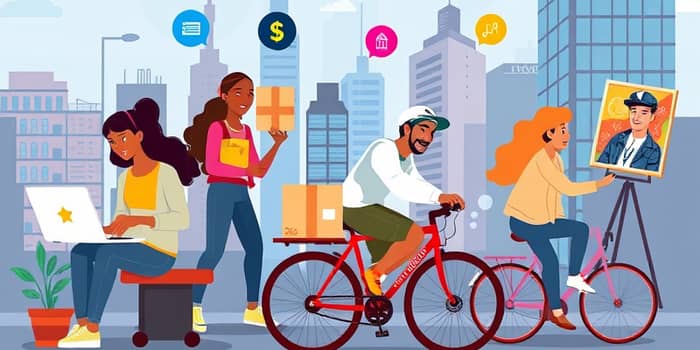
In an era marked by rising living costs and digital innovation, side hustles have become a lifeline for millions. From Gen Z creators selling handmade crafts online to seasoned professionals offering consulting services after hours, the gig economy shapes modern financial strategies like never before.
Recent data shows that between 27% and 40% of Americans now engage in secondary work, generating billions of dollars across global markets. This comprehensive guide explores the evolution, demographics, earnings, trends, and practical steps you need to take control of your financial future.
Side hustles surged during the post-pandemic recovery, peaking in 2022 when 44% of Americans held a secondary gig. While participation rates have dipped slightly to around 36% in 2025, the underlying momentum remains strong.
Inflationary pressures and a competitive job market have fueled this shift, transforming what was once termed “gig work” into a mainstream economic pillar. Businesses leverage freelance talent for agility, while individuals use multiple income streams to combat uncertainty.
Advancements in technology—particularly in AI and mobile platforms—have lowered barriers to entry. Today, anyone with a smartphone and internet access can list services, create digital products, or join delivery networks, reaffirming the global economy for side hustles as a dynamic growth engine.
The appeal of sideline work spans generations, yet participation varies. Youthful Gen Z workers lead with up to 40% engagement, driven by social media marketplaces, content creation, and side projects that align with personal brands.
Millennials follow closely at 31%, drawn by e-commerce, freelance design, and consulting gigs that leverage their professional expertise outside traditional hours. Gen X and Baby Boomers participate at 23% and 22% respectively, often favoring part-time local services and specialized skill-based opportunities.
This breakdown highlights a significant gender pay gap, with men earning nearly double the average monthly amount of their female counterparts. Cultural factors, industry selection, and access to high-paying gigs all play roles in this disparity.
On average, side hustlers bring in between $885 and $1,215 per month. However, median figures tell a different story: many earn as little as $200 to $400 monthly, reflecting a skewed distribution where a few high-earners lift the average.
Nearly 28% of participants report under $50 in monthly earnings, while top performers—especially in consulting, coaching, and specialized digital services—can exceed $5,000. Time investment generally averages eight hours per week, imposing a valuable yet limited bandwidth.
Side hustle income often pays for critical needs: 35% cover living expenses, 41% indulge in discretionary spending, 28% allocate funds to savings, and 20% tackle debt repayment. For 61% of hustlers, life becomes unaffordable without this supplemental cash flow.
If forced to lose their side revenue, 46% would cut dining out first, 39% would reduce entertainment costs, and another 39% would trim shopping budgets—underscoring how deeply these gigs influence daily lifestyles.
Many hustlers start with online marketplaces, leveraging existing platforms to reach global customers. Freelancers benefit from a diverse client base, while delivery drivers and local service providers enjoy flexible scheduling and immediate payouts.
Emerging opportunities in AI-driven content creation, data dashboards, and AI spokesperson videos deliver premium rates. The fastest-growing local hustle in 2025? Mobile car washing, meeting demand for convenience and sustainability.
Motivations for side hustles are diverse yet interconnected. Rising housing costs, healthcare premiums, and student loan burdens drive many to find additional revenue streams. Others are spurred by passion projects or the desire to test entrepreneurial waters.
For 77% of side hustlers, extra income translates into improved life satisfaction, while 44% see it as a route to long-term financial security benefits. Yet the demands of multiple income streams can strain mental and physical health, prompting calls for sustainable pace-setting.
Establishing a successful side gig requires strategic planning and consistent effort. Whether you're balancing a full-time job or family responsibilities, these guidelines will help you scale effectively:
Embrace continuous learning by attending webinars, networking in forums, and seeking mentorship. As your reputation grows, consider raising rates or outsourcing repetitive tasks to boost capacity and maintain quality.
Looking ahead, the side hustle landscape will be shaped by AI integration, decentralized platforms, and the quest for passive income. Sellers of digital courses, templates, and subscription-based services will find fertile ground as consumers seek self-paced learning and specialized resources.
Local services that prioritize convenience—like on-demand home maintenance, mobile wellness clinics, and app-based tutoring—will also surge. Hustlers who harness technology, from automated marketing funnels to AI-driven analytics, will capture market share with lower overhead and personalized offerings.
Ultimately, sideline gigs represent more than a financial patch; they embody real-world financial empowerment strategies for an unpredictable economy. By approaching your side hustle with diligent planning, resilience, and a growth mindset, you can transform extra hours into meaningful, sustainable earnings.
As you embark on or refine your side hustle journey, remember that success is a blend of passion, perseverance, and adaptability. Seize the opportunities before you and chart a course toward lasting financial resilience.
References













